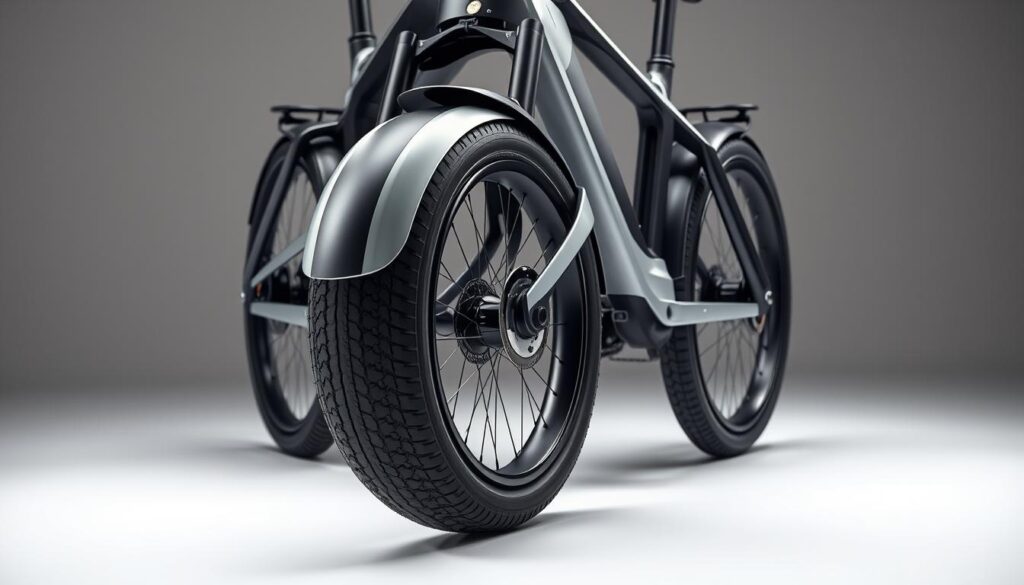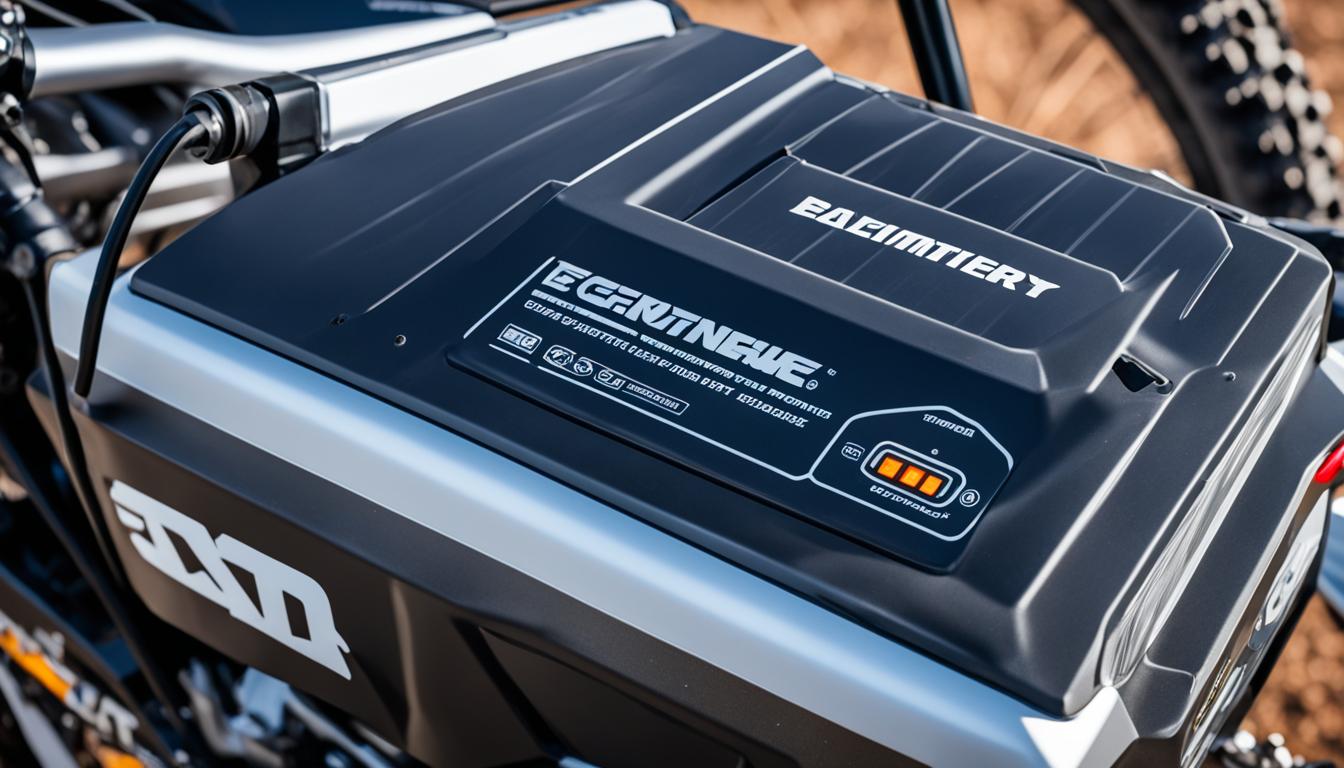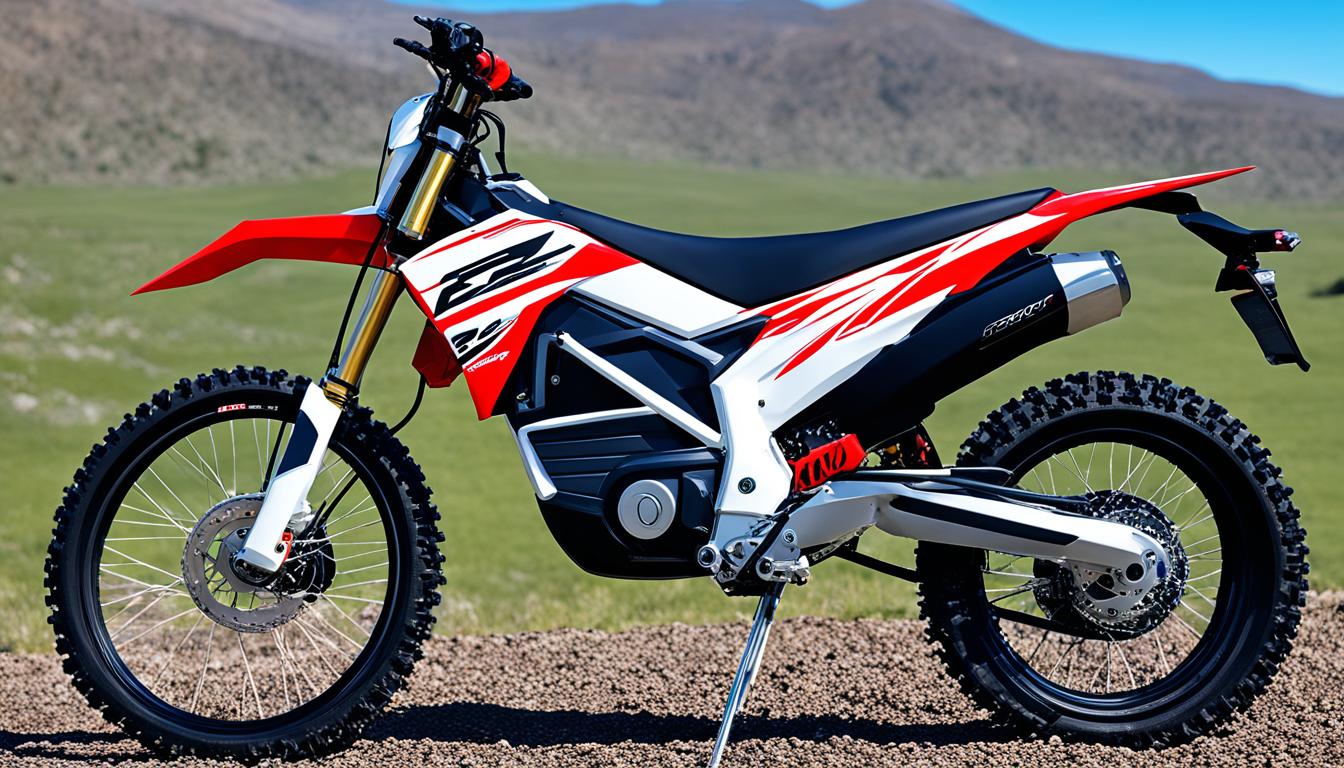Have you ever felt the thrill of a smooth, effortless ride, only to have it interrupted by a sudden bump or drag? The secret to a seamless experience often lies in something as simple as the air levels in your tires. Whether you’re cruising on a paved road or tackling rugged trails, maintaining the correct tire pressure can make all the difference.
For e-bikes, this is especially crucial. Proper air pressure not only enhances your ride but also extends your battery range and ensures safety. Did you know that even a small decimal difference in PSI can impact your bike’s performance1? For instance, lower pressure improves grip on rough terrain, while higher pressure boosts efficiency on smooth surfaces2.
Manufacturers often recommend a specific pressure range, typically between 2.5 to 4.0 bar, depending on your bike and riding conditions1. Regular checks with a reliable pressure gauge can help you stay within this range, ensuring a safer and more enjoyable ride. So, let’s dive into how you can optimize your e-bike’s performance with the right tire pressure.
Understanding the Importance of Tire Pressure
Riding an electric bike can be a breeze, but did you know your tire’s air levels play a huge role? Maintaining the correct tire pressure is essential for a safe, efficient, and enjoyable ride. It affects everything from handling to battery life.
Impact on Safety and Handling
Proper air pressure ensures better grip and stability, especially on uneven surfaces. Under-inflated tires can make handling tricky, increasing the risk of accidents. Over-inflated tires, on the other hand, reduce traction and make the ride less comfortable3.
For example, tires kept at the right PSI wear more evenly, reducing the chance of punctures and extending their lifespan3. This not only saves money but also keeps you safer on the road.
Effects on Battery Range and Motor Efficiency
Did you know that tire pressure can impact your e-bike’s battery range? Under-inflated tires increase rolling resistance, forcing the motor to work harder and draining the battery faster3. On the flip side, correctly inflated tires improve efficiency, allowing you to ride longer on a single charge.
For instance, most e-bikes perform best with a pressure range of 40 to 70 PSI, depending on the terrain and riding style3. This balance ensures optimal motor performance and battery life.
| Riding Condition | Recommended PSI |
|---|---|
| Leisurely Rides | 40-50 PSI |
| City Riding | 50-70 PSI |
| Off-Road Trails | 20-35 PSI |
| Fat Tire E-Bikes | 20-30 PSI |
By keeping your tires at the right pressure, you’ll enjoy a smoother ride, better battery efficiency, and improved safety. It’s a small step that makes a big difference!
How to Determine the Right Tire Pressure
Finding the perfect balance for your ride starts with understanding the right air levels. Whether you’re cruising on smooth roads or tackling rugged trails, the correct tire pressure ensures safety, efficiency, and comfort. Let’s break down how to find the ideal PSI for your needs.
Manufacturer Recommendations and Labels
Your first step is to check the sidewall of your tires. Most manufacturers print the recommended pressure range directly on the tire. For e-bikes, this is typically between 2.5 to 4.0 bar4. This range ensures optimal performance and safety for your specific model.
Always consult your tire’s manual or label for precise guidelines. Overinflation can reduce grip and make the ride uncomfortable, while underinflation increases the risk of punctures and wear4. Sticking to the recommended range is key.
Considering Rider Weight and Terrain
Your weight and the type of terrain you’re riding on also play a role. For every kilogram of rider weight above the average of 75 kilograms, adjust the PSI by 1%4. For example, if you weigh 85 kilograms, increase the pressure by 10% from the recommended range.
Terrain matters too. On smooth tarmac, aim for the upper limit (4.0 bar) to reduce rolling resistance4. For gravel or slippery surfaces, lower the pressure to the minimum (2.5 bar) for better grip4. These adjustments ensure a safer and more enjoyable ride.
As one expert puts it,
“The right tire pressure is a balance between efficiency, safety, and comfort. Always tailor it to your specific needs.”
Tools and Techniques for Checking Tire Pressure
Accurate tire maintenance begins with reliable tools and techniques. Whether you’re a seasoned rider or new to electric bikes, knowing how to check air levels ensures a smoother, safer experience. Let’s explore the two most common methods: built-in gauges on air pumps and separate pressure gauges.
Built-In Pressure Gauges on Air Pumps
Modern air pumps, like those from Magicycle, often come with built-in gauges. These tools are convenient because they allow you to measure and adjust air levels in one step. Simply attach the pump to the valve, inflate, and read the PSI directly from the gauge5.
Built-in gauges are ideal for quick adjustments before every ride. They’re especially useful for riders who prefer efficiency and simplicity. However, it’s important to calibrate these gauges regularly to ensure accuracy6.
Using Separate Tire Pressure Gauges
Separate gauges offer precision and versatility. These devices are designed specifically for measuring air pressure, providing readings with minimal error. To use one, attach it to the valve and check the PSI displayed5.
Many riders prefer separate gauges for their reliability. They’re also portable, making them a great addition to your toolkit. For the most accurate results, choose a high-quality gauge and store it properly to avoid damage7.
| Method | Pros | Cons |
|---|---|---|
| Built-In Gauges | Convenient, all-in-one solution | May require regular calibration |
| Separate Gauges | Highly accurate, portable | Additional tool to carry |
Regardless of the method you choose, checking air levels before every ride is essential. This simple step improves safety, extends tire life, and enhances your overall experience. As one expert puts it,
“Regular checks with a reliable gauge are the foundation of proper tire maintenance.”
Adjusting Tire Pressure for Various Conditions
Weather and terrain can significantly influence your ride, but did you know your tire’s air levels are equally crucial? From scorching heat to rugged trails, maintaining the right air levels ensures safety, efficiency, and comfort. Let’s explore how to adapt your tire pressure for different conditions.
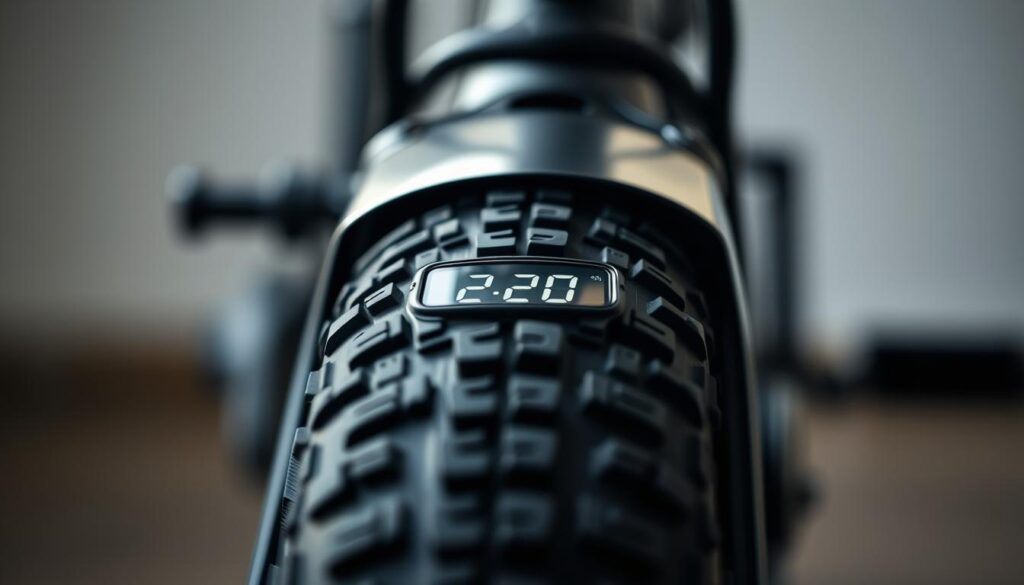
Changes in Temperature and Weather Effects
Temperature changes can directly impact your tire pressure. For every 10°F drop, air levels can decrease by approximately 1 PSI8. In colder weather, check your PSI more frequently to avoid underinflation, which can lead to reduced grip and increased rolling resistance9.
On hot days, air expands, increasing the risk of overinflation. To prevent blowouts, slightly reduce your PSI during high temperatures9. Regularly monitoring these changes ensures optimal performance and safety throughout the year.
Road, Trail, and Off-Road Adjustments
Different terrains require specific air level adjustments. On smooth roads, higher PSI (closer to the upper limit) reduces rolling resistance and improves speed9. For city riding, aim for 50-70 PSI for a balance of efficiency and comfort10.
For rugged trails or off-road conditions, lower PSI enhances traction and shock absorption. On soft surfaces like mud or sand, reducing air levels increases the contact area, preventing slippage9. For technical trails, a medium PSI of 12-20 strikes the right balance between grip and stability10.
| Condition | Recommended PSI |
|---|---|
| Smooth Roads | 50-70 PSI |
| Off-Road Trails | 12-20 PSI |
| Mud or Sand | 5-10 PSI |
| Technical Trails | 20-25 PSI |
As one expert notes,
“Adapting your tire pressure to the terrain and weather ensures a safer, more enjoyable ride. Always test adjustments in controlled conditions to find the perfect balance.”
By understanding these factors, you can tailor your air levels to any condition, enhancing your ride’s performance and safety. Regular checks and adjustments are key to maintaining optimal tire pressure throughout the season.
Common Mistakes and Risks with Incorrect Pressure
Maintaining the right air levels in your tires is more than just a routine—it’s a safety essential. Even small deviations from the recommended PSI can lead to significant risks, affecting both your ride and your safety. Let’s explore the dangers of overinflation and underinflation, and how to avoid them.
Overinflation: A Recipe for Trouble
Overinflating your tires might seem like a way to boost efficiency, but it comes with serious risks. When tire pressure is too high, the ride becomes harsh and uncomfortable. Worse, it increases the chance of a blowout, especially on rough surfaces11.
For example, exceeding the recommended PSI can cause the tire to lose grip, making it harder to control your ride12. Always stick to the manufacturer’s guidelines to avoid these pitfalls.
Underinflation: Hidden Dangers
On the flip side, underinflated tires can be just as problematic. Low air pressure increases rolling resistance, forcing the motor to work harder and draining the battery faster11. It also raises the risk of pinch flats, which can leave you stranded mid-ride.
For instance, tires with insufficient PSI wear unevenly, reducing their lifespan and compromising safety12. Regular checks with a reliable gauge can help you stay within the optimal range.
“Even minor miscalculations in tire pressure can lead to major issues. Regular checks are the best way to ensure a safe and smooth ride.”
By understanding these risks, you can take proactive steps to maintain the right air levels. Regular inspections and adjustments are key to avoiding common mistakes and ensuring a safer, more enjoyable experience.
Embracing Tire Pressure Sensors for Real-Time Monitoring
Modern technology is revolutionizing how we maintain our rides, making it easier than ever to stay safe and efficient. One of the most exciting advancements is the integration of tire pressure sensors, which provide real-time data to enhance your experience. These smart tools are designed to keep you informed and in control, ensuring optimal performance at all times.
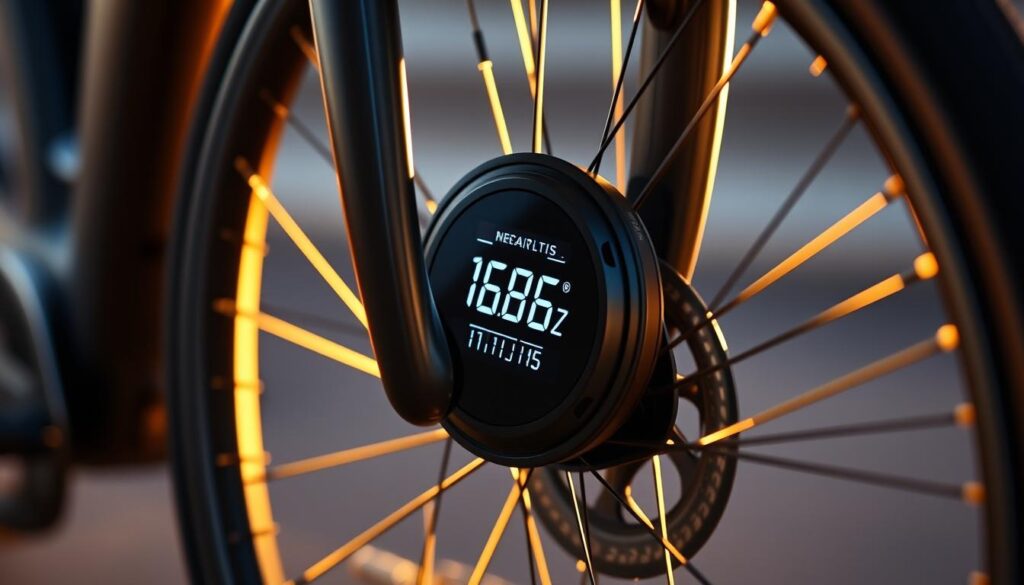
How Tire Pressure Sensors Function
Tire pressure sensors work by continuously monitoring the air levels in your tires. They use advanced technology to measure PSI and transmit this data via Bluetooth to your smartphone or bike display13. For example, systems like FIT TPMS provide instant feedback, allowing you to make adjustments on the go14.
These sensors are typically installed inside the tire or attached to the valve stem. They track changes in pressure and temperature, sending alerts if levels fall outside the recommended range15. This ensures you’re always aware of your tire’s condition, even during long rides.
Advantages of Continuous Pressure Monitoring
One of the biggest benefits of these sensors is the ability to receive real-time alerts. If your tire pressure drops too low or rises too high, you’ll get an immediate notification14. This early warning system helps prevent issues like punctures or blowouts, keeping you safe on the road.
Continuous monitoring also enhances your bike’s performance. By maintaining the correct PSI, you reduce rolling resistance and improve battery efficiency13. This means longer rides and fewer stops for adjustments.
| Feature | Benefit |
|---|---|
| Real-Time Alerts | Prevents accidents and punctures |
| Bluetooth Integration | Easy access to data via smartphone |
| Continuous Monitoring | Ensures optimal performance |
As one expert notes,
“Real-time monitoring systems are a game-changer for riders. They provide peace of mind and ensure you’re always prepared for the road ahead.”
By embracing these smart tools, you can enjoy a safer, more efficient ride while staying ahead of potential issues. Whether you’re a casual rider or a seasoned cyclist, tire pressure sensors are a valuable addition to your toolkit.
EV bike tire pressure guide: Best Practices for Regular Maintenance
Keeping your ride smooth and safe starts with consistent maintenance of your tires. Regular checks and adjustments ensure optimal performance and extend the life of your e-bike. Here’s how to stay on top of it.
Weekly pressure checks are essential. Tires can lose up to 1 bar of air per month, so staying consistent prevents issues16. Use a high-quality pump with a built-in gauge or a separate pressure gauge for accurate readings. This simple step can save you from unexpected flats and improve your ride quality.
Seasonal changes and periods of non-use require extra attention. Temperature fluctuations can affect air levels, so check more frequently during extreme weather17. If your e-bike sits unused for a while, inspect the tires before your next ride to ensure they’re ready to go.
Here’s a quick checklist for easy maintenance:
- Check air levels weekly.
- Adjust for temperature changes.
- Use quality tools for accurate readings.
- Inspect tires before long rides.
Manufacturers recommend specific pressure ranges, usually printed on the tire sidewall. Exceeding this range increases the risk of blowouts, while underinflation reduces efficiency and safety16. Stick to the guidelines for the best results.
| Maintenance Tip | Benefit |
|---|---|
| Weekly Checks | Prevents air loss and flats |
| Seasonal Adjustments | Ensures optimal performance year-round |
| Quality Tools | Provides accurate readings |
| Pre-Ride Inspections | Enhances safety and readiness |
“Regular maintenance isn’t just a chore—it’s the key to a safer, smoother ride. Stay consistent, and your e-bike will thank you.”
By following these best practices, you’ll keep your e-bike in top shape. Regular maintenance ensures safety, improves performance, and extends the life of your tires. Make it a habit, and enjoy the ride!
Conclusion
Ensuring your e-bike performs at its best starts with one simple habit: regular air level checks. Proper tire pressure enhances safety, efficiency, and overall ride quality. It’s not just about avoiding flats—it’s about maximizing your experience.
Adhering to manufacturer recommendations is crucial. For most e-bikes, the ideal PSI ranges between 40 to 70, depending on terrain and rider weight18. Regular checks with a reliable gauge ensure you stay within this range, preventing risks like blowouts or uneven wear19.
Technology like tire pressure sensors can make maintenance easier. These tools provide real-time alerts, helping you stay on top of adjustments18. By maintaining the right pressure, you’ll enjoy smoother rides, better battery life, and improved safety.
Make it a routine to inspect your tires before every ride. Small steps like these can make a big difference. Start today and experience the benefits of optimal tire pressure!
Source Links
- Electric Bike Tire Pressure Guide
- Ebike Tire Pressure Best Practices
- What Tire Pressure Do You Set for Your Electric Bikes?
- E-bike tire pressure – how to always ride with the right level | Biketec GmbH
- How To Check Your E-Bike’s Tire Pressure
- Electric Bike Tire Pressure Guide
- Ebike Tire Pressure Best Practices
- Optimizing E-Bike Tire Pressure: A Comprehensive Guide
- Electric Bike Tire Pressure Guide
- Ebike Tire Pressure Best Practices
- Electric Bicycle Tire Pressure [Getting Started Guide]
- Electric Bike Tire Pressure Guide
- E-bikes and Connectivity: WTH is a Connected E-Bike? – Laka
- Smart Tools for Cyclists: App-Connected Maintenance Devices – Bike New Zealand
- Guide to Fat E-Bike Tire Pressure for Optimal Performance and Comfort | Himiway CA
- Electric Bike Tire Pressure Guide
- Ebike Tire Pressure Best Practices for Maintaining The Right Tire Pressure
- What Tire Pressure Do You Set for Your Electric Bikes?
- Mastering E-Bike Tire Pressure: A Comprehensive Guide
